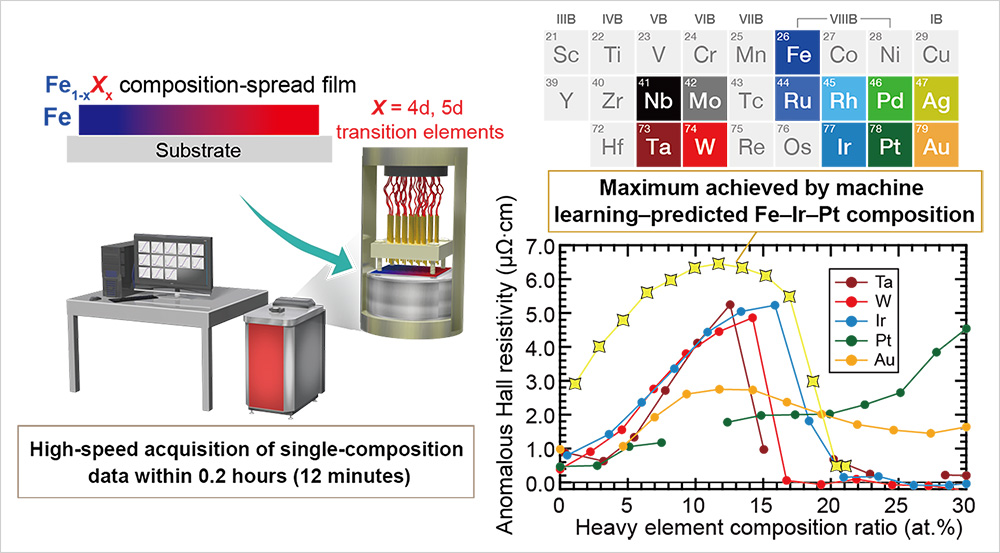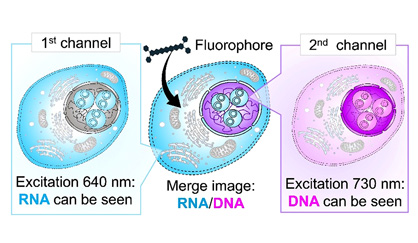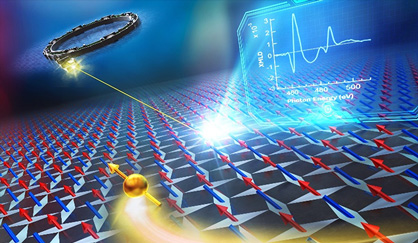Discovery of a New Magnetic Sensor Material Using a High-Throughput Experimental Method
— Ultra-Efficient Materials Development Enabled by AI-Driven Data Analysis and Prediction —2025.09.04
NIMS (National Institute for Materials Science)
Japan Science and Technology Agency (JST)
A NIMS research team has developed a new experimental method capable of rapidly evaluating numerous material compositions by measuring anomalous Hall resistivity 30 times faster than conventional methods. By analyzing the vast amount of data obtained using machine learning and experimentally validating the predictions, the team succeeded in developing a new magnetic sensor material capable of detecting magnetism with much higher sensitivity. This research was published in npj Computational Materials on September 3, 2025.
Abstract
Background
Alloys containing three or more elements that exhibit a large anomalous Hall effect are considered particularly promising as novel materials. However, the number of possible combinations of elements and their composition ratios is enormous—a so-called combinatorial explosion—and because evaluating each sample is time-consuming, this vast search space has remained largely unexplored. As a result, there is a strong need to establish both experimental methods capable of efficiently evaluating the anomalous Hall effect in thin-film samples and techniques for effectively identifying promising materials within this vast search space.
Key Findings
Using this approach, the team systematically investigated the anomalous Hall effect in binary thin films composed of iron (Fe) and a single heavy element. Based on the results, a machine learning model was constructed to predict ternary materials—comprising Fe and two heavy elements—likely to exhibit enhanced anomalous Hall effects. Guided by these predictions, the Fe–Ir–Pt (iron–iridium–platinum) system was identified as a promising candidate, and a novel material within this system exhibited an anomalous Hall resistivity of 6.5 µΩ·cm, surpassing the previous maximum value of 5.25 µΩ·cm observed in Fe–X binary systems.

Figure. High-speed characterization of the anomalous Hall effect via multichannel simultaneous measurement on an Fe1-xXx compositional gradient thin film. Each composition is characterized within 0.2 hours (12 minutes), achieving approximately a 30-fold increase in speed compared to conventional methods. The Fe–Ir–Pt composition predicted using machine learning exhibited a new maximum anomalous Hall resistivity.
Future Outlook
Going forward, the team plans to expand the materials search space to discover new materials with even larger anomalous Hall effects. In addition, this approach is expected to advance data-driven materials development using the extensive measurement data generated through combinatorial experiments and facilitate the development of faster, automated and autonomous materials discovery systems.
Other Information
- This project was carried out by a research team led by Ryo Toyama (Postdoctoral Researcher, Magnetic Functional Device Group (MFDG), NIMS at the time of the project), Yuya Sakuraba (Leader, MFDG, NIMS) and Yuma Iwasaki (Principal Researcher, Data-driven Materials Design Group, NIMS).
This work was conducted in conjunction with another project entitled “Exploring Innovative Materials in Unknown Search Space” under the JST Strategic Basic Research Program CREST (grant number: JPMJCR21O1), and with the MEXT DxMT project at the Digital Transformation Initiative Center for Magnetic Materials (grant number: JPMXP1122715503). - This research was published in npj Computational Materials, an open access journal, on September 3, 2025.
Published Paper
Authors : Ryo Toyama, Yuma Iwasaki, Prabhanjan D. Kulkarni, Hirofumi Suto, Tomoya Nakatani, and Yuya Sakuraba
Journal : npj Computational Materials
DOI : 10.1038/s41524-025-01757-5
Publication Date : September 3, 2025
Contact information
Regarding This Research
Group Leader, Magnetic Functional Device Group
Research Center for Magnetic and Spintronic Materials
National Institute for Materials Science
TEL: +81-29-859-2708
URL: https://www.nims.go.jp/mmu/mmg/ (Magnetic Functional Device Group | NIMS)
Media Inquiries
Division of International Collaborations and Public Relations
National Institute for Materials Science
1-2-1 Sengen, Tsukuba, Ibaraki 305-0047, Japan
TEL: +81-29-859-2026
FAX: +81-29-859-2017
Regarding JST Funding Programs
Green Innovation Group, Department of Strategic Basic Research
Japan Science and Technology Agency
K's Gobancho, 7 Gobancho, Chiyoda-ku, Tokyo 102-0076, Japan
TEL: +81-3-3512-3531
FAX: +81-3-3222-2066
Same Keywords
-
Exceptionally Large Transverse Thermoelectric Effect Produced by Combining Thermoelectric and Magnetic Materials
(anomalous Hall effect)
2024.03.07
-
Increasing High-Temperature Strength of Materials Through Collaborative Efforts of AI and Materials Researchers
(AI)
2023.09.25
-
Development of NIMS-OS: General-Purpose Software Enabling Autonomous, Automated Experiments
(AI)
2023.07.20



